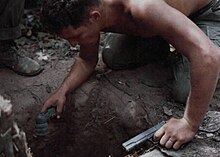Tunnel rat
This article needs additional citations for verification. (July 2010) |


The tunnel rats were American, Australian and New Zealander soldiers who performed underground search and destroy missions during the Vietnam War.
Later, similar teams were used by the Soviet Army during the Soviet war in Afghanistan, and the Israel Defense Forces.
Vietnam War
During the Vietnam War "tunnel rat" became a more or less official specialty for volunteer infantrymen, primarily from the United States, Australia and New Zealand. Their motto was the Latin phrase "Non Gratus Rodentum"—"not worth a rat".[1] Since the 1940s, during the war against the French colonial forces, the Viet Cong had created an extensive underground system of complexes. By the 1960s, there were underground hospitals, training grounds, storage facilities, headquarters and more. The Viet Cong, who were skilled at guerrilla warfare, might stay underground for several months at a time. The tunnels were their territory.
Whenever troops would uncover a tunnel, tunnel rats were sent in to kill any hiding enemy soldiers and to plant explosives to destroy the tunnels. A tunnel rat was equipped with only a standard issue .45 caliber pistol, a bayonet and a flashlight, although most tunnel rats were allowed to choose another pistol with which to arm themselves. The tunnels were very dangerous, with numerous booby traps and enemies lying in wait.
The tunnels presented many potential threats: enemy soldiers manned holes on the sides of tunnels through which spears could be thrust, impaling a crawling intruder. Not only were there human enemies, but also dangerous creatures, such as snakes (including venomous ones, sometimes placed there as living booby traps), rats, spiders, scorpions and ants. Black-Bearded Tomb Bats (Taphozous melanopogon) and Lesser Dawn Bats (Eonycteris spelaea) also roosted in the tunnels, though they were a harmless nuisance if awakened. Often there were flooded U-bends in the tunnels to trap poison gas. Underground, gas could be a very deadly weapon, and a tunnel rat might choose to go into the tunnels wearing a gas mask as it would be impossible to put one on in a narrow tunnel. More often than not, however, a tunnel rat would take his chances without a gas mask, as wearing one made it even harder to see, hear and breathe in the narrow, dark tunnels.

Due to the confined space, the tunnel rats disliked the intense muzzle blast of the comparatively large .45 caliber round,[citation needed] which would often leave them temporarily deaf, and it was not uncommon for them to use whatever handgun they might find. The Soviet-made pistols the enemy carried were particular favorites, but they were rare, and the soldiers would often have someone at home send them a civilian pistol or revolver. Among the favorites were the smaller German Luger or less-common double action Walther pistols, both chambered in 9×19mm. Many of these were brought home by American troops returning from World War II. Others would trade their pistols for revolvers used by other personnel. Many used improvised suppressors on their pistols to further reduce the noise.[citation needed] A particularly favored weapon was a specially modified Smith & Wesson Model 39 known as the "Hush Puppy". Unlike the standard Model 39, the Mark 22 featured a threaded barrel, 14 round magazine and a slide stop lever.
Tunnel rats were generally, but not exclusively, men of smaller stature (5'6" and under) in order to fit in the narrow tunnels.[2] Mangold and Penycate claimed that the tunnel rats were almost exclusively White or Hispanic soldiers and that the majority of American Latinos were Puerto Rican or Mexican American.[3] Such tactics came to prominence following their successful application in January 1966 during a combined US–Australian action against the Củ Chi tunnels in Bình Dương Province, known as Operation Crimp.[3]
Afghanistan
Afghanistan has an extensive series of historic tunnels used for transporting water, the kariz, and during the 1979–1989 Soviet war in Afghanistan, such tunnels were used by Mujahideen fighters. The Soviet 40th Army had their own tunnel rats, who were tasked with flushing people out of the tunnels, then going through the tunnels to disarm booby traps and kill those who remained.[4] The United States Marine Corps and the Royal Marines are involved in similar work during the current ongoing war in Afghanistan.[5][6]

Israel
A similar team called SAMOOR ("Weasel") is part of Yahalom elite combat engineering unit.[7]
Notes
- ^ Dodd, Jan; Lewis, Mark. The Rough Guide to Vietnam. Penguin Group. 2009.
- ^ "The Tunnel Rats of Viet Nam". Viet Nam. Digger History: an unofficial history of the Australian & New Zealand Armed Forces.
- ^ a b Mangold, Tom; John Penycate (2005). The Tunnels of Cu Chi. Presidio Press. ISBN 0-89141-869-5.
- ^ Grau, Lester W.; Ali Ahmad Jalali (November 1998). "Underground Combat: Stereophonic Blasting, Tunnel Rats and the Soviet-Afghan War". Engineer.
- ^ "Taliban using ancient well and tunnel system"
- ^ "Taliban Secret Weapon: Ancient Irrigation Trenches"
- ^ "Israel's 'tunnel rats' brace for new guerrilla war", Mar 8, 2012 Reuters
References
- Mangold, Tom; John Penycate (2005). The Tunnels of Cu Chi. Presidio Press. ISBN 0-89141-869-5.
- Rottman, Gordon (2006). Viet Cong and NVA Tunnels and Field Fortifications of the Vietnam War. Osprey Publishing. ISBN 1-84603-003-X.
- Kirchner, Paul (2009). More of the Deadliest Men Who Ever Lived. Paladin Press. ISBN 978-1-58160-690-4.
External links
- Australian Tunnel Rats
- Tunnel rats in Vietnam
- The short film STAFF FILM REPORT 66-17A (1966) is available for free viewing and download at the Internet Archive.
- The short film STAFF FILM REPORT 66-18A (1966) is available for free viewing and download at the Internet Archive.
- The short film STAFF FILM REPORT 66-25A (1966) is available for free viewing and download at the Internet Archive.
